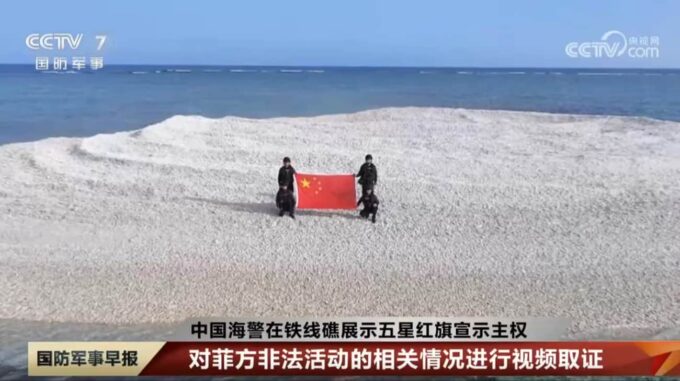China officially declared its presence on the disputed Sand Cay reef in the South China Sea, raising concerns in the region and increasing tensions among the countries involved

On Saturday, the U.S. government’s news agency, citing data from the Financial Times, reported that the Chinese Coast Guard raised its national flag on this small but strategically important reef, located just a few kilometers from the Philippine military outpost on Titu Island and other key regional sites. This marked the first official act in many years confirming Beijing’s intention to establish a presence on this feature, which China considers its territory. According to sources, this event was the result of actions by the Chinese Coast Guard, which placed its flag there, asserting sovereignty over the reef, considered a contested territory. The CCTV news channel stated that this was a form of maritime control and a demonstration of jurisdiction over the object. Photos circulated through official channels show Chinese officers installing a flag on the reef, provoking a wave of sharp political and security assessments. The significance of this event cannot be overstated: although Sand Cay is a small sandy atoll covering only about 200 square meters, it holds strategic importance for Beijing. It creates a so-called maritime zone with a radius of 12 nautical miles, allowing China to control a vital sector in the South China Sea. This is especially relevant given the tensions between China and the Philippines, which utilize their islands and reefs to monitor and control Chinese movements in the area. However, for the Philippine side, this incident poses a challenge to years-long policies of deterrence and strengthening defense positions. Institutional measures, including modernization of the coast guard and active patrols since the end of 2023, aim to assert control over their territories and oppose any attempts at reclamation and occupation. Manila’s federal authorities are engaging scientific teams to verify reports of reclamation works on Sand Cay and other disputed reefs, striving to preserve the status quo and prevent these islands from being transformed into Chinese military bases. Meanwhile, experts emphasize that there are currently no direct signs of large-scale construction or permanent occupation of Sand Cay by China. A Philippine security official stated that the Chinese Coast Guard left the territory after raising the flag. Reports indicate that Philippine forces have a base on Titu Island, which they plan to bolster and modernize, including building new runways and infrastructure to create a more robust defense shield. Nevertheless, the situation remains extremely tense. Military analysts estimate that immediate seizure of additional islands by China in the near future is unlikely: China has already developed artificial islands and military bases in the region over the past decade, which have been militarized and expanded by Beijing. This long-term process has enabled China to establish a sufficient military presence and control capabilities in the region without open large-scale aggression. At the same time, China’s legislative framework grants it broad powers to stop and inspect vessels of foreign states in waters claimed by Beijing. This creates potential risks of conflicts with Philippine security forces and armed structures. The announcement of raising the flag and asserting sovereignty coincided unexpectedly with preparations for the upcoming Balikatan military exercises in the region, planned to be conducted jointly with the U.S. soon. These exercises include drills on coast guard operations, island seizure, and several other strategic activities. Beyond political and military aspects, this situation is contributing to increasing tension in the South China Sea, which remains one of the most conflict-prone areas in the world. The U.S. and the Philippines aim to maintain the balance of power and prevent provocations, but Chinese positional strengthening combined with increased military exercises exerts additional pressure on regional security mechanisms. Recall that in January of this year, the U.S. and the Philippines conducted their fifth joint maritime exercise in the region, aimed at enhancing cooperation and deterring the escalating competition in the South China Sea. A more active presence and demonstrations of power form part of the broader strategy of regional players, but the actual responsibility for maintaining balance and preventing escalation still rests on diplomacy and restraint. Thus, the situation in the South China Sea has again become acute, and the international community is closely watching developments, as their progression largely impacts regional security and stability in Asia.

